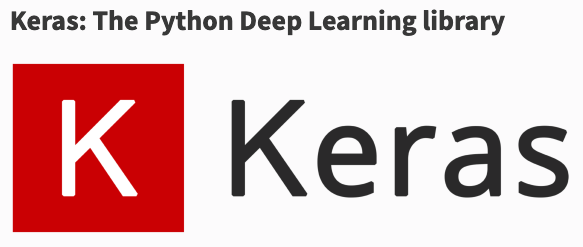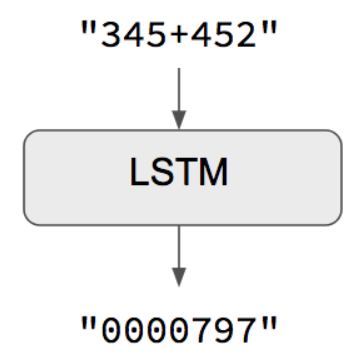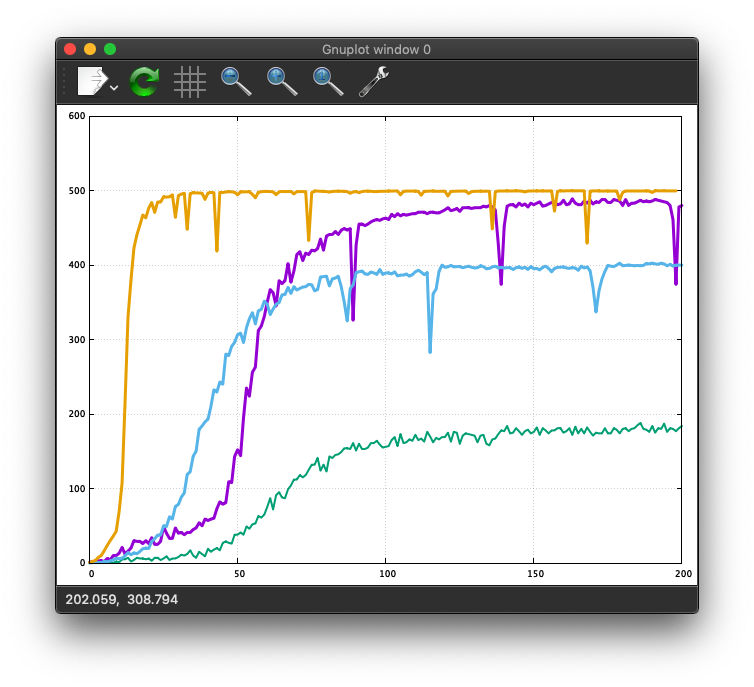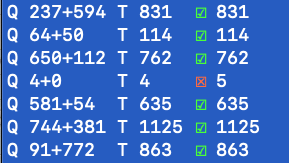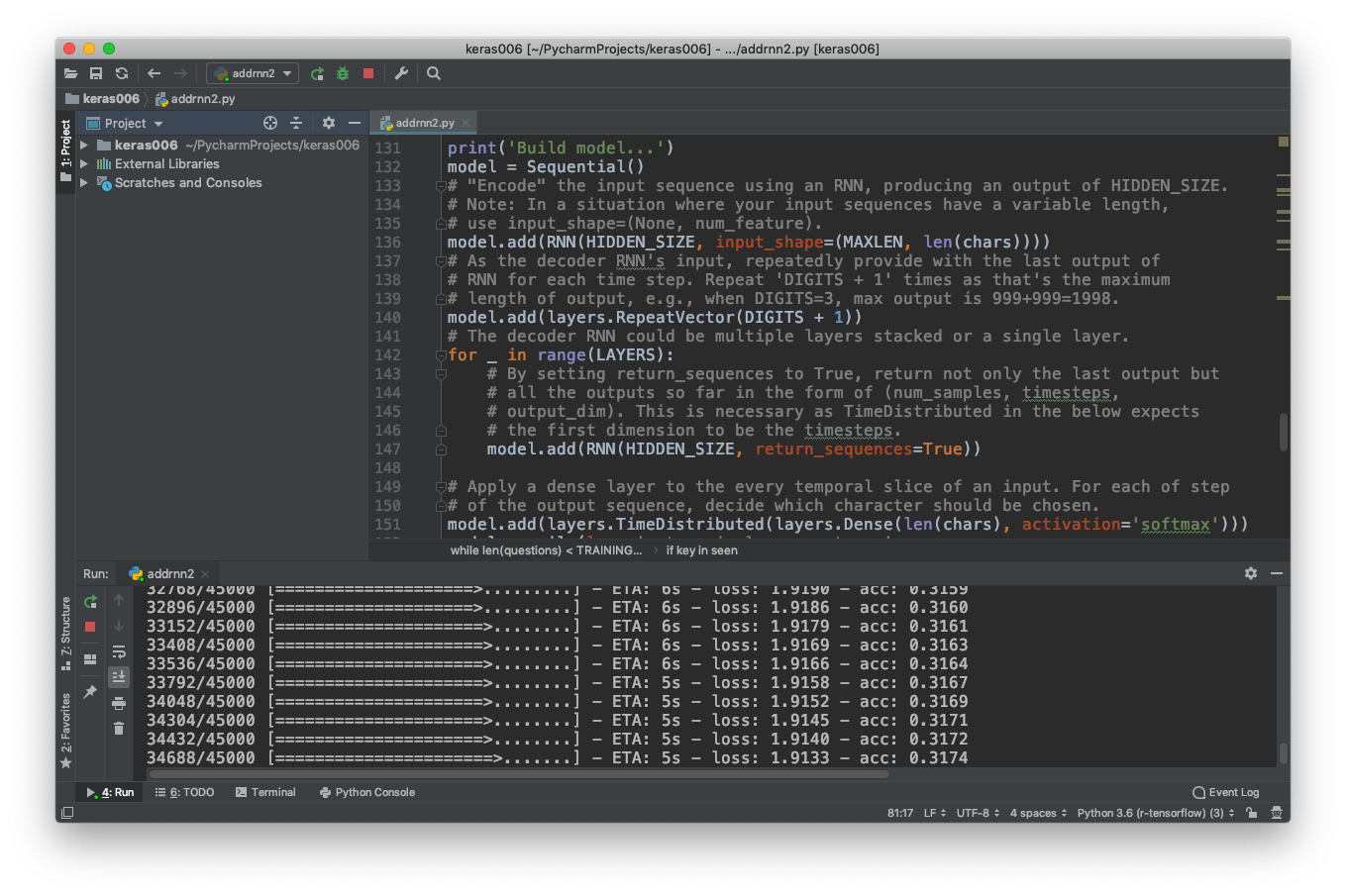One simple example is here:
https://keras.io/examples/addition_rnn/
https://blog.keras.io/a-ten-minute-introduction-to-sequence-to-sequence-learning-in-keras.html
LSTM stands for Long short-term memory, a kind of a recurrent neural network (RNN).
Some learning curves are shown in the Figure with different hyperparameters.
Naturally, the prediction is not perfect.
from keras.models import Sequential
from keras import layers
import numpy as np
from six.moves import range
class CharacterTable(object):
"""Given a set of characters:
+ Encode them to a one-hot integer representation
+ Decode the one-hot or integer representation to their character output
+ Decode a vector of probabilities to their character output
"""
def __init__(self, chars):
"""Initialize character table.
# Arguments
chars: Characters that can appear in the input.
"""
self.chars = sorted(set(chars))
self.char_indices = dict((c, i) for i, c in enumerate(self.chars))
self.indices_char = dict((i, c) for i, c in enumerate(self.chars))
def encode(self, C, num_rows):
"""One-hot encode given string C.
# Arguments
C: string, to be encoded.
num_rows: Number of rows in the returned one-hot encoding. This is
used to keep the # of rows for each data the same.
"""
x = np.zeros((num_rows, len(self.chars)))
for i, c in enumerate(C):
x[i, self.char_indices] = 1
return x
def decode(self, x, calc_argmax=True):
"""Decode the given vector or 2D array to their character output.
# Arguments
x: A vector or a 2D array of probabilities or one-hot representations;
or a vector of character indices (used with `calc_argmax=False`).
calc_argmax: Whether to find the character index with maximum
probability, defaults to `True`.
"""
if calc_argmax:
x = x.argmax(axis=-1)
return ''.join(self.indices_char[x] for x in x)
class colors:
ok = '\033[92m'
fail = '\033[91m'
close = '\033[0m'
# Parameters for the model and dataset.
TRAINING_SIZE = 50000
DIGITS = 3
REVERSE = True
# Maximum length of input is 'int + int' (e.g., '345+678'). Maximum length of
# int is DIGITS.
MAXLEN = DIGITS + 1 + DIGITS
# All the numbers, plus sign and space for padding.
chars = '0123456789+ '
ctable = CharacterTable(chars)
questions = []
expected = []
seen = set()
print('Generating data...')
while len(questions) < TRAINING_SIZE:
f = lambda: int(''.join(np.random.choice(list('0123456789'))
for i in range(np.random.randint(1, DIGITS + 1))))
a, b = f(), f()
# Skip any addition questions we've already seen
# Also skip any such that x+Y == Y+x (hence the sorting).
key = tuple(sorted((a, b)))
if key in seen:
continue
seen.add(key)
# Pad the data with spaces such that it is always MAXLEN.
q = '{}+{}'.format(a, b)
query = q + ' ' * (MAXLEN - len(q))
ans = str(a + b)
# Answers can be of maximum size DIGITS + 1.
ans += ' ' * (DIGITS + 1 - len(ans))
if REVERSE:
# Reverse the query, e.g., '12+345 ' becomes ' 543+21'. (Note the
# space used for padding.)
query = query[::-1]
questions.append(query)
expected.append(ans)
print('Total addition questions:', len(questions))
print('Vectorization...')
x = np.zeros((len(questions), MAXLEN, len(chars)), dtype=np.bool)
y = np.zeros((len(questions), DIGITS + 1, len(chars)), dtype=np.bool)
for i, sentence in enumerate(questions):
x[i] = ctable.encode(sentence, MAXLEN)
for i, sentence in enumerate(expected):
y[i] = ctable.encode(sentence, DIGITS + 1)
# Shuffle (x, y) in unison as the later parts of x will almost all be larger
# digits.
indices = np.arange(len(y))
np.random.shuffle(indices)
x = x[indices]
y = y[indices]
# Explicitly set apart 10% for validation data that we never train over.
split_at = len(x) - len(x) // 10
(x_train, x_val) = x[:split_at], x[split_at:]
(y_train, y_val) = y[:split_at], y[split_at:]
print('Training Data:')
print(x_train.shape)
print(y_train.shape)
print('Validation Data:')
print(x_val.shape)
print(y_val.shape)
# Try replacing GRU, or SimpleRNN.
RNN = layers.LSTM
HIDDEN_SIZE = 128
BATCH_SIZE = 128
LAYERS = 1
print('Build model...')
model = Sequential()
# "Encode" the input sequence using an RNN, producing an output of HIDDEN_SIZE.
# Note: In a situation where your input sequences have a variable length,
# use input_shape=(None, num_feature).
model.add(RNN(HIDDEN_SIZE, input_shape=(MAXLEN, len(chars))))
# As the decoder RNN's input, repeatedly provide with the last output of
# RNN for each time step. Repeat 'DIGITS + 1' times as that's the maximum
# length of output, e.g., when DIGITS=3, max output is 999+999=1998.
model.add(layers.RepeatVector(DIGITS + 1))
# The decoder RNN could be multiple layers stacked or a single layer.
for _ in range(LAYERS):
# By setting return_sequences to True, return not only the last output but
# all the outputs so far in the form of (num_samples, timesteps,
# output_dim). This is necessary as TimeDistributed in the below expects
# the first dimension to be the timesteps.
model.add(RNN(HIDDEN_SIZE, return_sequences=True))
# Apply a dense layer to the every temporal slice of an input. For each of step
# of the output sequence, decide which character should be chosen.
model.add(layers.TimeDistributed(layers.Dense(len(chars), activation='softmax')))
model.compile(loss='categorical_crossentropy',
optimizer='adam',
metrics=['accuracy'])
model.summary()
# Train the model each generation and show predictions against the validation
# dataset.
for iteration in range(1, 200):
correct_count = 0
error_count = 0
print()
print('- ' * 50)
print('Iteration', iteration)
model.fit(x_train, y_train,
batch_size=BATCH_SIZE,
epochs=1,
validation_data=(x_val, y_val))
# Select 10 samples from the validation set at random so we can visualize
# errors.
for i in range(len(x_val)):
rowx, rowy = x_val[np.array([i])], y_val[np.array([i])]
preds = model.predict_classes(rowx, verbose=0)
q = ctable.decode(rowx[0])
correct = ctable.decode(rowy[0])
guess = ctable.decode(preds[0], calc_argmax=False)
print('Q', q[::-1] if REVERSE else q, end=' ')
print('T', correct, end=' ')
if correct == guess:
print(colors.ok + '☑' + colors.close, end=' ')
correct_count = correct_count + 1
else:
print(colors.fail + '☒' + colors.close, end=' ')
error_count = error_count + 1
print(guess)
print("score = ", correct_count / (correct_count+error_count))

